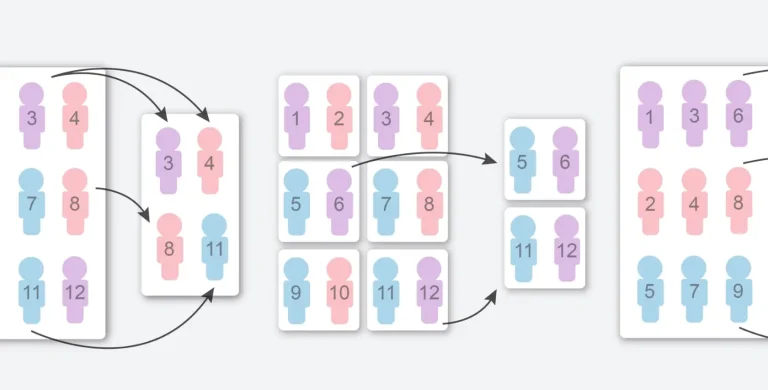Are you taking the AP Statistics exam and are wondering how it is scored? Well, we’ve got your back! By the end of this article, you will have a clear idea of whether AP Stats could be the right choice for you. Keep reading!
How Does Scoring Work on the AP Statistics Test?
The AP Statistics Exam is scored on a scale of 1 to 5, with each score reflecting a specific level of achievement. The scoring process involves both multiple-choice questions (MCQs) and free-response questions (FRQs).
The following table shows how the composite score is distributed across the 2 sections:
| Type of Questions | Points |
|---|---|
| Section I: 40 Multiple-choice Questions | 50 points |
| Section II: 6 Free-Response Questions | 50 points |
| Subtotal | 100 points |
As you can see from the table above, the 50 points in the MCQ section are distributed across 40 questions. Roughly, each correct answer carries 1 point. Now, are you penalized for guessing on the AP Statistics exam? NO! The exam does not penalize you for wrong answers, so never leave a question blank, even if you are unsure of the correct answer.
In Section II, each question carries roughly 4 points, totaling 50 points for six questions. These questions are graded holistically. This means your grade is awarded based on the overall quality of your answer and not on the small bits of correct information or formulas you present on the answer sheet. The College Board® has developed the following grading rubric for each free-response question:
- 4: Complete Response: Demonstrates a thorough understanding of the statistical components of the problem.
- 3: Substantial Response: Although there may be arithmetic errors, the answers are still reasonable and demonstrate a thorough understanding of the problem's statistical components.
- 2: Developing Response: This may contain errors that result in some illogical answers, but it demonstrates some understanding of the problem's statistical components.
- 1: Minimal Response: Misapplies or fails to apply appropriate statistical techniques and demonstrates a limited understanding of statistical components by failing to identify important components
- 0: No Response: This demonstrates a lack of understanding of statistical components and also applies if the question is not attempted at all.
This grading rubric implies that if you only include a few correct equations or arithmetic answers, you won't earn many points. To get a good score on these questions, you must demonstrate that you understand how to use statistics.
AP Statistics Raw Score Conversion
Once your total points from each section are calculated, they are added to present your final composite score which is then converted into the AP scaled score, ranging from 1 to 5. The raw score conversion process is kept confidential by the College Board. Your composite score on the AP Exam is never presented publicly. You only get the AP Exam grade (1-5) which is calculated after processing your composite raw score on your AP mark sheet.
AP Statistics Scoring Table
After your AP Statistics exam scores are recorded on the AP grading scale, they are sent to the colleges you’ve selected. To learn how to have the College Board send your AP scores to your college, visit our page on AP Exam Scores.
Although each college has its own criteria for granting credit and/or placement based on AP scores, most colleges follow a standard formula for converting your AP Stats score into the equivalent college grade. Below is the AP score table showing the conversion of AP scores into equivalent college grades for the Stats exam:
| AP Score | College Grade Equivalent | Qualification |
|---|---|---|
| 5 | A+ or A | Extremely well qualified |
| 4 | A-, B+, or B | Very well qualified |
| 3 | B-, C+, or C | Qualified |
| 2 | — | Possibly Qualified |
| 1 | — | No recommendation |
As shown in the table, colleges generally do not consider scores below 3 for admissions purposes. Therefore, aim for a score of 3 or higher if you're hoping to earn college credit or Advanced Placement for your AP Stats exam score. However, always check with the colleges you're applying to for their specific minimum requirements.
AP Statistics Score Distributions
AP Stats is one of the most popular AP exams taken by students every year. This is because Stats is one of the most versatile AP courses that can earn you Advanced Placement and/or course credit as you enter college, even if you have not finalized your college major. There are numerous other benefits of taking your AP exam for Statistics. Check out our AP Statistics Exam Guide to discover why taking the Stats exam is beneficial for your career.
The AP Statistics score distribution gives insights into exam performance trends. In 2024, a total of 252,914 students took the AP Stats exam, with 61.8% of test-takers scoring a 3 or higher.
Here’s the AP Stats score distribution for 2024:
| AP Score | % of Students 2024 |
|---|---|
| 5 | 17.5% |
| 4 | 21.8% |
| 3 | 22.5% |
| 2 | 15.9% |
| 1 | 22.3% |
Contrary to popular myth, the AP Stats exam is a challenging subject, but you can be a 5 pointer with the right study tools, course instruction, and dedication.
UWorld’s online AP Statistics practice questions will help you get there. Taking practice tests will help you track your progress and clear out doubts to help you form a solid foundation of core statistics concepts. You can also make quick notes and use our flashcards to revise concepts and theorems in a jiffy when reviewing for the exam.

Scoring Pattern for the 2024, 2023, and 2022 AP Statistics Exams
To secure a good score on AP Stats, it is important to understand the scoring pattern for the exam. This will help you gauge whether a section might be a high scorer for you and which section you need to put more effort into.
-
While specific data on the performance of individual sections (multiple-choice and free-response) for the 2024 exam is not yet available, historical trends suggest that:
Multiple-Choice Section:
- Units 1-3: Historically, students have performed well on questions from these units.
- Probability and Simulation Questions: These have been more challenging, with performance varying across years.
Free-Response Section:
- Probability Distribution Questions: In previous years, students have scored well on these questions.
- Skill Category 3 (Probability and Simulation): This category has been more challenging, with average correct responses varying across years.
-
Let us look at the 2023 AP Statistics scoring pattern and learn how scores were distributed across the multiple-choice and free-response sections:
For the multiple-choice section:
- Students performed better on questions from Units 1 - 3, and almost 37,000 students earned perfect scores on MCQs from Unit 3.
- MCQs on probability and simulation were the most challenging, but the performance was better than 2022, with 47 % students answering them correctly.
For the free-response questions:
- Students scored best on Question 3 focusing on probability distribution, with almost 27,000 students earning all 4 points for it.
2022 exam scores show the following pattern for the MCQs:
- Units 1-3 were high scorers, with almost 20% of students earning perfect scores across all MCQs on these three units.
For the free-response section:
- Students struggled with Skill Category 3: Probability and Simulation, averaging 38% correct on probability and simulation questions, far lower than for skills 1, 2, and 4.
- Students performed well on FRQ no. 4, and almost 30% earned perfect scores on this question.
AP Statistics Minimum Score Requirement for College Credits
As we mentioned earlier, most colleges across the US recognize AP exam scores to grant credit or advanced placement to their students. Having an AP statistics score of 3 or higher can earn you college credits, which will help you graduate from college early because of the credits you have already earned in high school through AP. While in other colleges, a score of 3 or higher can give you a chance to skip the core statistics course in the first semester and still get a grade for it, which gets labeled as ‘advanced placement’. Some colleges offer both advanced placement and credit, which means you will earn the credits and also be able to skip the course.
Each institution has its own criteria for acknowledging AP Statistics scores. Some colleges accept an AP score of 3, while some demand a 5. Some colleges do not offer you any credit but grant you a placement for your AP score. So, while you are preparing for your AP Statistics exam, it is essential to know your college entrance requirements for this course.
We have compiled a list of colleges around the country and the AP scores they accept for admission to help you narrow your search. Let us have a look:
| Institution | AP Score |
AP Recognition |
Credit/Placement type | Notes |
|---|---|---|---|---|
| Grinnell College | 4 | Credit + Placement |
4 as SST-115 | For major credit for departments that require SST-115 except for Political Science. |
| Harvard University | 5 | - | 4 | Applicable upon activation of “Advanced standing” |
| Louisiana State University at Alexandria | 3 | Credit + Placement |
MATH 2011/STAT/PSYC 2011 | 3 credit hrs |
| Massachusetts Institute of Technology | N/A | Not Awarded | N/A | N/A |
| Mississippi State University | 3 | Credit + Placement |
ST 2113 | 3 credit hrs |
| University of Notre Dame | 5 | Credit+Placement | ACMS 10091 | 3 credit hrs |
| Reed College | N/A | Not Awarded | N/A | N/A |
| Stanford University | N/A | Not Awarded | N/A | N/A |
| Truman State University | 3 | Credit + Placement |
STAT 190 | 3 |
| University of California at Los Angeles | 3/4/5 | Credit | Unassigned | 4 |
| Yale University | N/A | Not Awarded | N/A | N/A |

Frequently Asked Questions
When do AP Statistics scores come out?
What is a good AP Statistics score?
What are some ways to increase my AP Statistics score?
References
- (2024). Past AP Statistics Score Distributions. (n.d.). AP Students. Retrieved on December 19, 2024, from https://apstudents.collegeboard.org/about-ap-scores/score-distributions/ap-statistics
- (2020). AP® Statistics COURSE AND EXAM DESCRIPTION. (n.d.). collegeboard.org. Retrieved on December 19, 2024, from https://apcentral.collegeboard.org/media/pdf/ap-statistics-course-and-exam-description.pdf?course=ap-statistics
- (2023, June 28). Packer. The 2023 AP Statistics scores. twitter.com. Retrieved December 19, 2024, from https://twitter.com/AP_Trevor/status/1673775612987691010?lang=en
- (2022). Chief Reader Report on Student Responses: 2022 AP® Statistics Free-Response Questions. (n.d.). College Board. Retrieved on December 19, 2024, from https://apcentral.collegeboard.org/media/pdf/ap22-cr-report-statistics.pdf
- (2023). Chief Reader Report on Student Responses: 2023 AP® Research Free-Response Questions. (n.d.) Retrieved on December 19, 2024, from https://apcentral.collegeboard.org/media/pdf/ap23-cr-report-research.pdf
Read More About the AP Statistics Exam
Confused about the AP Statistics Exam format? Discover its exam structure and question types that you need to know to boost confidence and kickstart preparation!
How to Study for AP Statistics
Don't waste time looking for the perfect guide! Check out our guide on AP Statistics study plan for the essential review tips on the most commonly tested topics.
AP Statistics Course and Exam Description
A simple course and exam description will save a lot of time. Here's our easy-to-understand AP Statistics CED that clearly explains units, topics, and concepts.
Best AP Statistics Study Guide Comparison
Explore top AP Statistics study guides to find the best resources for the exam. Compare features, pros, cons and reviews to select the perfect guide for success.
Best AP Statistics Prep Course Review
Discover the best AP Statistics prep courses available. Compare key features, pricings, reviews, and benefits to select the course that best fits your learning.
How to Self-Study for AP Statistics
Learn effective tips and strategies to self-study for the AP Statistics exam. Build confidence, master core concepts, and achieve a high score independently too.




